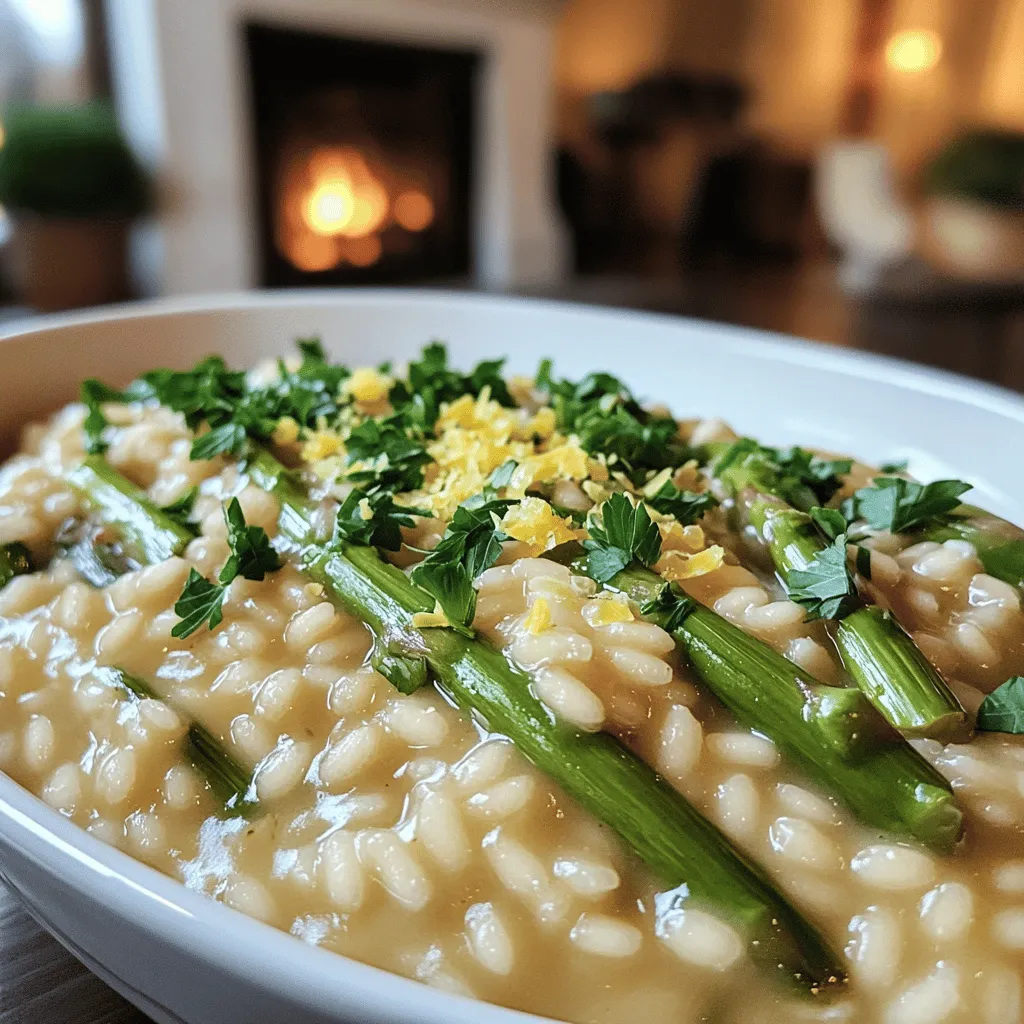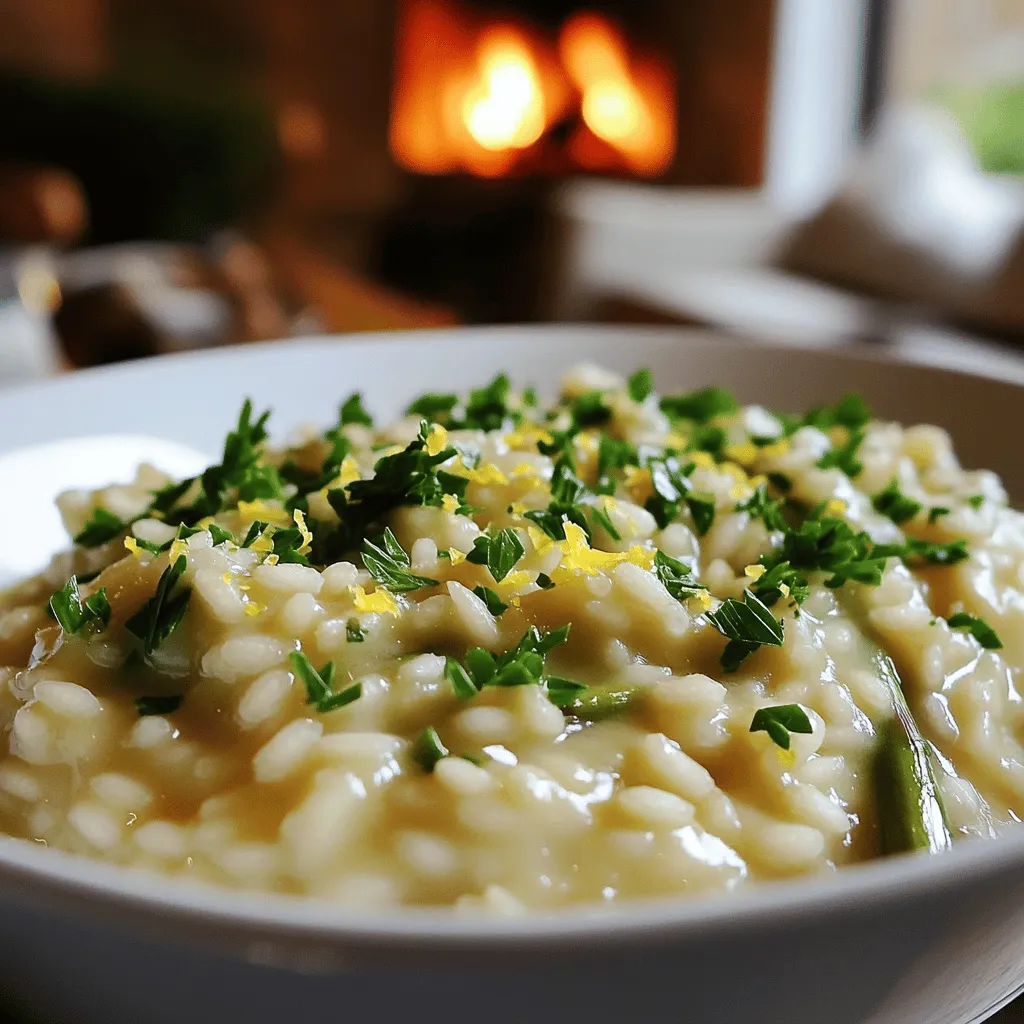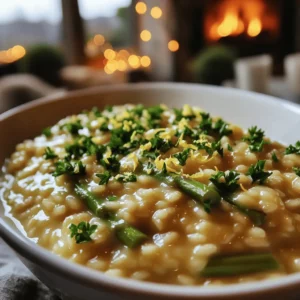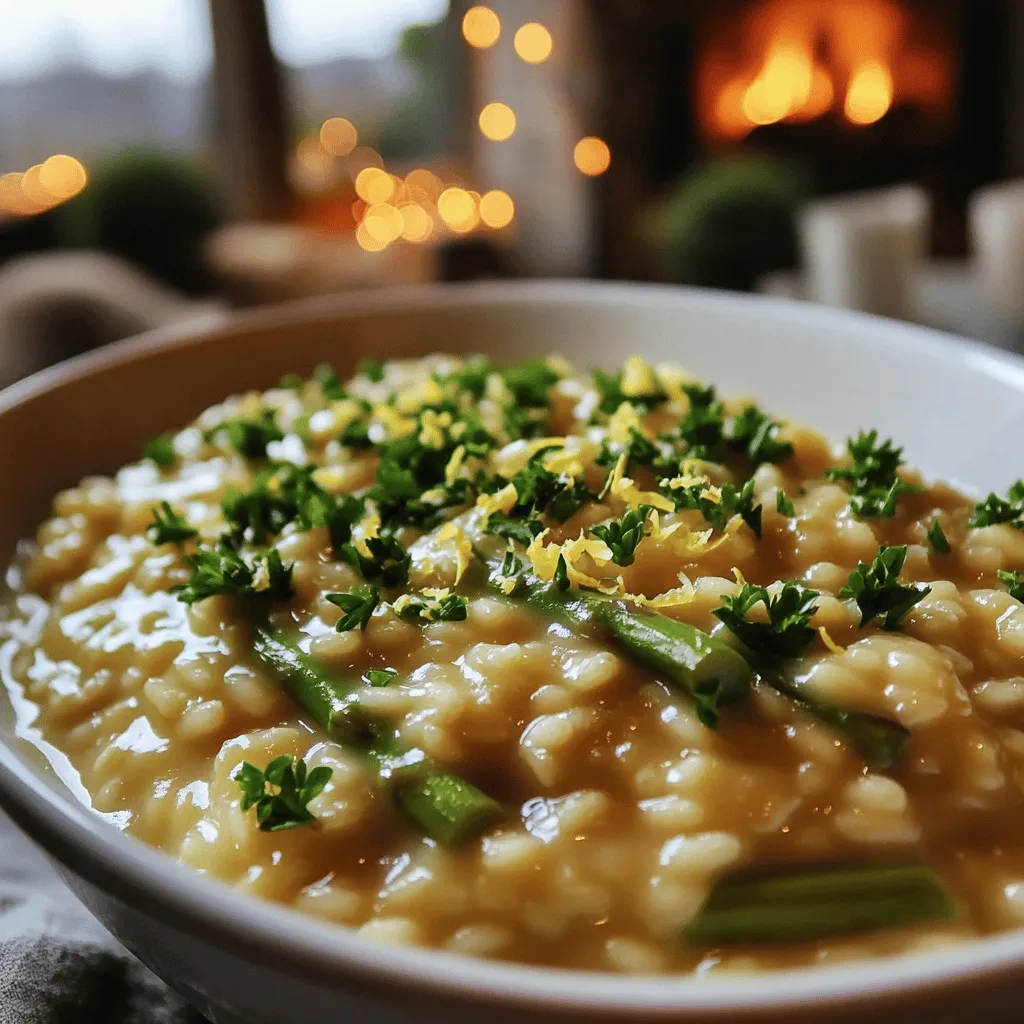If you’re craving a dish that’s both rich and simple, you’ve found the right recipe! My Risotto Asperges Parmesan is a creamy delight that combines tender asparagus with savory parmesan cheese. It’s not just comfort food; it’s a vegetarian masterpiece that will impress anyone at your dinner table. In this post, I’ll share everything you need to know about making this perfect risotto from scratch. Let’s dive in!
What Ingredients Do You Need for Risotto Asperges Parmesan?
For a great risotto with asparagus and parmesan, you need simple, fresh ingredients. Here’s what I use:
1. Arborio rice: This rice is key for creamy asparagus risotto. It has a high starch content that gives risotto its famous texture.
2. Asparagus: I like to use a whole bunch of asparagus. Trim it and cut it into small pieces for even cooking.
3. Vegetable broth: Use four cups of warm vegetable broth. It adds depth and flavor to the dish.
4. Onion and garlic: A medium onion and three cloves of garlic add great taste. Chop them finely for even cooking.
5. Olive oil and butter: I use one tablespoon of each. They help sauté the onion and garlic, giving a rich flavor.
6. Parmesan cheese: I recommend one cup of freshly grated Parmesan for that creamy finish.
7. Cream: Adding half a cup of cream makes the risotto extra smooth. You can use heavy or light cream.
8. Lemon zest: The zest of one lemon adds brightness and freshness to the dish.
9. Salt and pepper: Don’t forget to season to taste.
10. Fresh parsley: I use it for garnish. It adds color and a hint of freshness.
Can You Substitute Any Ingredients?
Yes, you can substitute some ingredients if needed. For example, you can use any short-grain rice if you can’t find Arborio. However, the texture might change. If you want a lighter risotto, you can skip the cream, but it will not be as rich. You can also use chicken broth if you are not vegetarian.
How Does Freshness Impact the Flavor?
Fresh ingredients make a big difference. Fresh asparagus gives a vibrant taste and bright color. Using freshly grated Parmesan cheese adds a creamy texture and rich flavor. The zest of a fresh lemon brightens the dish, making it more appealing. Fresh herbs, like parsley, provide a pop of color and flavor. Always aim for the freshest veggies and herbs to elevate your risotto.
For a detailed cooking guide, check the Full Recipe.
How Do You Make Risotto Step by Step?
What Are the Steps to Prepare the Risotto?
To make risotto, start by heating vegetable broth in a saucepan. Keep it warm on low heat. In a large skillet, heat olive oil and butter over medium heat. Add finely chopped onion and sauté until it’s soft, about 3 to 4 minutes. Next, add minced garlic and cook for one more minute until it smells great.
Now, add the Arborio rice to the skillet. Toast it for 1 to 2 minutes while stirring. This step makes the rice slightly translucent. After that, begin adding the warm broth, one ladleful at a time. Stir well and wait for the rice to absorb the liquid before adding more. This process takes about 20 minutes.
When you have about 10 minutes left, add the asparagus pieces. Stir them in gently until they become tender and bright green. Once the rice is creamy and al dente, take it off the heat. Mix in the cream and grated Parmesan cheese. Don’t forget to add lemon zest and season with salt and pepper. Let it sit briefly to thicken before serving.
How Long Does the Cooking Process Take?
The entire cooking process takes about 35 minutes. This includes 10 minutes for prep and 25 minutes for cooking. You will find that the time spent caring for your risotto is worth it. It rewards you with a rich, creamy dish.
What Cooking Tools Do You Need?
To make risotto, you need a few key tools. A large skillet or saucepan is essential for cooking the rice. A medium saucepan is needed for the broth. You will also need a wooden spoon for stirring and a ladle for adding broth. Finally, have your measuring cups and a sharp knife ready for chopping. These tools will help you create your creamy asparagus parmesan risotto with ease. For the full recipe, please refer to the details above.

What Are Some Tips for Perfect Risotto Texture?
To create the best risotto, focus on texture. A creamy and smooth risotto feels like a warm hug. Here are my top tips to achieve that perfect risotto texture.
How to Achieve Creamy Consistency?
Start with Arborio rice. This rice has a high starch content. Starch gives risotto its creamy texture. When you cook it slowly, the rice releases this starch. Add warm broth gradually while stirring. This method helps the rice absorb liquid evenly. Stirring often makes the risotto creamy and smooth.
What Is the Right Rice for Risotto?
The best rice for risotto is Arborio. It is short-grain and plump. You can also use Carnaroli or Vialone Nano. Both types have similar qualities. They absorb liquid well and create a creamy dish. Avoid long-grain rice. It does not have enough starch for a nice risotto.
How to Avoid Overcooking or Undercooking the Rice?
Keep an eye on the cooking time. Normally, risotto takes about 18 to 20 minutes. Taste the rice around the 15-minute mark. You want it al dente, firm yet soft. If it is crunchy, it needs more time. If mushy, you cooked it too long. Always use warm broth. Cold broth shocks the rice and slows cooking. This method helps you cook it just right.
How Can You Enhance the Flavor of Your Risotto?
To improve the flavor of your risotto, consider adding herbs and spices. Fresh herbs like parsley, tarragon, or basil work well. They bring a bright taste that pairs nicely with creamy dishes. Dried herbs, like thyme or oregano, can also add depth. Just remember to use them sparingly to avoid overpowering the dish.
What Herbs and Spices Work Well?
Thyme is a great choice for risotto. It has a warm, earthy flavor that enhances the dish. You can also use dill, which adds a fresh taste that complements asparagus. For a kick, a pinch of red pepper flakes can bring heat without overwhelming the creaminess. Always taste as you go to find the right balance.
How to Incorporate Other Vegetables?
Adding other vegetables is easy. You can mix in peas, spinach, or mushrooms. These vegetables not only add color but also layers of flavor. Just sauté them before adding to the rice. For example, cook mushrooms until browned, then stir them in. This step adds umami and a rich taste.
Can You Add Different Types of Cheese?
Yes! Cheese can change the flavor profile of your risotto. While Parmesan is classic, you can try others. Aged Gouda adds a nutty flavor, while goat cheese gives a tangy twist. Mixing cheeses can also create a more complex taste. Just be careful not to add too much, as it might overwhelm the dish.
Experimenting with herbs, vegetables, and cheeses can elevate your risotto. Each choice allows you to customize the dish to your liking. For the full recipe, check out the full recipe section.

What Are Some Creative Variations of Asparagus Risotto?
You can explore many risotto variations that keep things fresh and fun. Seasonal risotto ideas let you use what is ripe and tasty at any time. For spring, try adding peas or fresh herbs like mint. In the fall, butternut squash adds a sweet touch. You can also use mushrooms for an earthy flavor any time of year.
Want to make this dish special for a holiday? You can add shrimp or crab for a fancy touch. For a vegetarian feast, mix in roasted vegetables. You can even swap asparagus for other greens, like spinach or kale, for a different taste. This dish is versatile and can fit any occasion.
Other great ingredients to pair with asparagus include lemon zest and garlic. The brightness of lemon wakes up the dish. Garlic adds depth and warmth. You can also stir in some fresh herbs like basil or dill for extra flavor. If you’re feeling adventurous, try adding a splash of white wine while cooking. It will give your risotto a nice kick.
For a creamy risotto, remember to use enough cheese. Parmesan is great, but you can also try goat cheese or feta. These cheeses have unique flavors that can change the dish. When you want to impress guests, feel free to experiment with gourmet risotto ideas.
Check out the Full Recipe for all the details you need to make this delicious dish.
How Do You Serve and Garnish Risotto After Cooking?
After cooking your risotto, serving it well is key.
What Are the Best Serving Suggestions?
I like to serve risotto in wide bowls. This gives a rustic look. You can make it feel special by adding a drizzle of olive oil. A sprinkle of lemon zest brightens the dish and adds flavor. Serve it warm for the best taste.
How to Garnish for Visual Appeal?
For garnish, I chop fresh parsley and sprinkle it on top. This adds a pop of green. You can also add more grated Parmesan cheese for extra richness. A few lemon slices on the side can enhance the dish’s look. It makes the meal feel festive.
What Wine Pairs Well with Risotto?
A nice white wine pairs well with risotto. I recommend a dry Sauvignon Blanc. Its crisp taste complements the creamy flavors of the dish. Another great choice is a light Pinot Grigio. Both options enhance the meal and make it feel special.
For the full recipe, check out the Creamy Asparagus Parmesan Risotto.
In this blog post, we explored how to make Risotto Asperges Parmesan. We discussed essential ingredients, cooking steps, and tips for perfect texture. Fresh ingredients can make a big difference in flavor. Enhancing your risotto with herbs, spices, and various cheeses adds depth. We also looked at creative variations and serving suggestions.
Remember, cooking risotto is both an art and a science. With practice, you can master this dish and impress anyone at your table. Enjoy making your creamy asparagus risotto!








